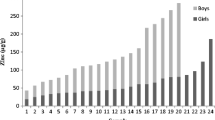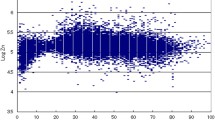Abstract
Zinc deficiency is a health problem in many communities especially among adolescents because of pubertal growth sprout. This investigation was carried out to determine the epidemiology of zinc deficiency in junior high school students in Tehran City in 1997. This cross-sectional study was performed on 881 students (452 males and 429 females) with the mean age of 13.2±1.0 yr, who were selected by multistage random sampling method. Plasma, erythrocyte, and hair zinc levels were assayed by flame atomic absorption spectrophotometry. Anthropometric and demographic characteristics were measured and recorded on a questionnaire. Dietary intakes were evaluated by a 24-h recall method. Zinc deficiency was defined as having at least two indices from indices of erythrocyte, plasma, and hair zinc below 10 µg/mL, 100 µg/dL, and 125 µg/g of hair, respectively.
The results showed that zinc deficiency prevalence was 31.1% (confidence interval: 28–34.4%). Zinc deficiency was 65%, 49%, and 1.3% based on plasma, erythrocyte, and hair zinc levels, respectively. The mean ± SD for plasma, erythrocyte, and hair zinc concentration, height-for-age, as well as weight-for-age Z scores were 95.2±17.7 µg/dL, 10.3±2.3 µg/mL, 239.4±54.4 µg/g, −0.40±0.92, and 0.12±0.91, respectively. As for dietary intake compared with the RDA, 50% of the subjects consumed less than 50% of their requirement for zinc RDA based on a 24-h dietary recall. Zinc intake in subjects was 7.5±3.7 µg, that in boys was higher than in girls. Correlation coefficients between zinc status indices were very weak. There was neither a linear nor nonlinear relationship between biochemical parameters and nutritional zinc intake. It is concluded that almost one-third to one-half of the subjects would be considered zinc deficient.
Similar content being viewed by others
References
C. A. Burtis and E. R. Ashwood, Tietz Textbook of Clinical Chemistry, WB Saunders, Philadelphia, pp 1329–1333 (1994).
J. C. King and C. L. Keen, Zinc, in Modern Nutrition in Health and Disease, M. E. Shils, J. A. Olson, and M. Shike, Lea & Febiger, Philadelphia, pp. 214–229 (1994).
L. K. Mahan and M. Arlin, Zinc, in Krause’s Food, Nutrition and Diet Therapy, WB Saunders, Philadelphia, pp. 123–126 (1992).
D. C. McLaren, D. Burman, N. R. Belton, and A. F. Williams, Textbook of Paediatric Nutrition, 3/e, Churchill Livingtone, Edinburgh, Scotland, pp. 462–468 (1991).
H. H. Sandstead, Requirement and toxicity of essential trace elements, illustrated by zinc and copper, Am. J. Clin. Nutr. 61(Suppl.), S621–624 (1995).
A. E. Favier, Hormonal effects of zinc on growth in children, Biol. Trace Element Res. 32, 383–397 (1992).
M. L. Bishop et al., Clinical Chemistry. Principles, Procedures, Correlation, 2nd ed. JB Lippincott, Philadelphia, pp. 290–292 (1992).
N. W. Tietz, Clinical Guide to Laboratory Tests, WB Saunders, Philadelphia, pp. 650–653 (1995).
World Health Organization, Measuring Changes in Nutritional Status, Geneva, 1983.
F. Fidanza, Nutritional Status Assessment, Chapman & Hall, New York, pp. 385–395 (1991).
R. C. Whitehouse, A. S. Prasad, P. I. Rabbani, and Z. T. Cossack, Zinc in plasma, neutrophils, lymphocyte, and erythrocytes determined by flameless atomic absorption spectrophotometry, Clin. Chem. 28, 475–480 (1982).
M. D. Stevens, W. F. Mackenize, and V. D. Anand, A simplified method for determination of zinc in whole blood, plasma, and erythrocytes by atomic absorption spectrophotometry. Biochem. Med. 18, 158–163 (1977).
S. M. Pilch and F. R. Senti, Analysis of zinc data from the second National Health and Nutrition Examination Survey (NHANES II), J. Nutr. 115, 1393–1397 (1985).
J. Eminians, J. G. Reinhold, G. A. Kfoury, G. H. Amirhakimi, H. Sharif, and M. Ziai, Zinc nutrition children in Fars of province of Iran, Am. J. Clin. Nutr. 20, 734–742 (1967).
P. D. Vanderkooy and R. S. Gibson, Food consumption patterns of Canadian preschool children in relation to zinc and growth status, Am. J. Clin. Nutr. 45, 609–616 (1987).
L. D. McBean, M. Mahloudji, J. G. Reinhold, and J. A. Halsted, Correlation of zinc concentrations in human plasma and hair, Am. J. Clin. Nutr. 24, 506–509 (1971).
P. Thompson, R. Roseborough, E. Russek, and R. B. Moser, Zinc status and sexual development in adolescent girls, J. Am. Dietetic Assoc. 86, 892–897 (1986).
R. S. Gibson, P. D. S. Vanderkooy, A. C. MacDonald, A. Goldman, B. A. Ryan, and M. Berry, A growth-limiting, mild zinc-deficiency syndrome in some southern Ontario boys with low height percentiles, Am. J. Clin. Nutr. 49, 1266–1273 (1989).
J. P. Van Wouwe, Clinical and laboratory assessment of zinc deficiency in Dutch children, a review, Biol. Trace Element Res. 49, 211–225 (1995).
K. R. Cavan, R. S. Gibson, C. F. Grazioso, A. M. Isalgue, and M. Ruz, Growth and body composition of periurban Guatemalan children in relation to zinc status: a cross-sectional study, Am. J. Clin. Nutr. 57, 334–343 (1993).
N. Heinersdorff and T. G. Taylor, Concentration of zinc in the hair of school children, Arch. Dis. Child. 54, 958–960 (1979).
L. Perrone, R. Moro, and M. Caroli, Trace elements in hair of healthy children sampled by age and sex, Biol. Trace Element Res. 51, 71–76 (1996).
R. S. Gibson, A. Heywood, C. Yaman, A. Sohlström, L. U. Thompson, and P. Heywood, Growth in children from the Wosera subdistrict, Papua New Guinea, in relation to energy and protein intakes and zinc status, Am. J. Clin. Nutr. 53, 782–789 (1991).
M. Kimiagar, L. Navai, M. Yassai, F. Malek, and B. Samimi, Zinc intake and bioavailability in a Tehran suburb. What is the minimum requirement? in Nutrient Availability, Chemical and Biological Aspects, D. Southgate, et al., eds., Royal Society of Chemistry, London, pp. 421–424 (1989).
A. J. Thomas, V. W. Bunker, L. J. Hinks, N. Sodha, M. A. Mullee, and B. E. Clayton, Energy, protein, zinc and copper status of twenty-one elderly patients: analysed dietary intake and biochemical indices, Br. J. Nutr. 59, 181–191 (1988).
R. S. Gibson, Content and bioavailability of trace elements in vegetarian diets, Am. J. Clin. Nutr. 59(Suppl.), S1223–1232 (1994).
N. W. Solomons, Zinc bioavailability to humans, in Proceedings of the XIII International Congress of Nutrition, T. G. Taylor and N. K. Jenkins, eds., John Libby, UK, pp. 504–508 (1988).
A. Singh, B. A. Day, J. E. Debolt, U. H. Trostmann, L. L. Bernier, and P. A. Deuster, US Navy SEAL trainees, Am. J. Clin. Nutr. 49, 695–700 (1989).
J. Brandao-Neto, V. Stefan, B. B. Mendonca, and W. Bloise, The essential role of zinc in growth, Nutr. Res. 15, 335–358 (1995).
K. D. McClatchey, Clinical Laboratory Medicine, Williams & Wilkins, Baltimore, MD, p. 482 (1994).
B. Thomas, Manual of Dietetic Practice, Blackwell Science, Boston, pp 173–182 (1994).
Author information
Authors and Affiliations
Rights and permissions
About this article
Cite this article
Mahmoodi, M.R., Kimiagar, S.M. Prevalence of zinc deficiency in junior high school students of tehran city. Biol Trace Elem Res 81, 93–103 (2001). https://doi.org/10.1385/BTER:81:2:093
Received:
Revised:
Accepted:
Issue Date:
DOI: https://doi.org/10.1385/BTER:81:2:093




